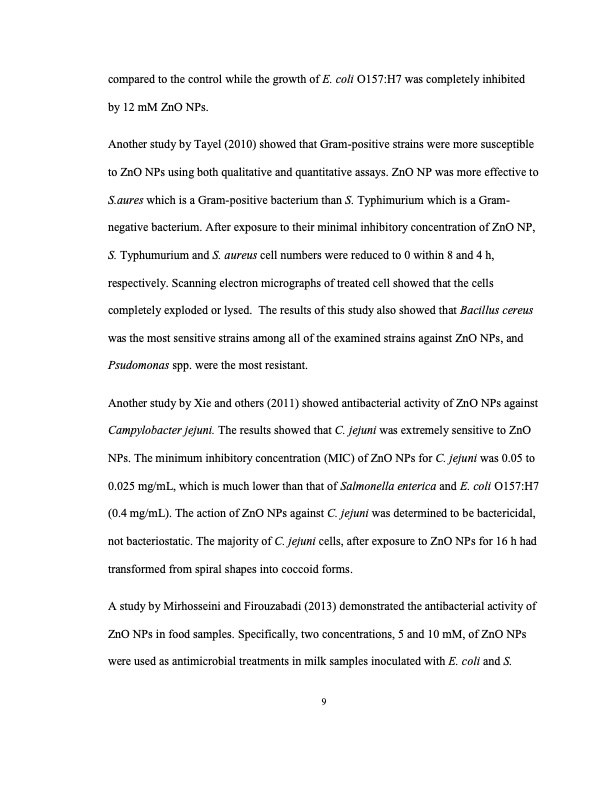
PDF Publication Title:
Text from PDF Page: 020
compared to the control while the growth of E. coli O157:H7 was completely inhibited by 12 mM ZnO NPs. Another study by Tayel (2010) showed that Gram-positive strains were more susceptible to ZnO NPs using both qualitative and quantitative assays. ZnO NP was more effective to S.aures which is a Gram-positive bacterium than S. Typhimurium which is a Gram- negative bacterium. After exposure to their minimal inhibitory concentration of ZnO NP, S. Typhumurium and S. aureus cell numbers were reduced to 0 within 8 and 4 h, respectively. Scanning electron micrographs of treated cell showed that the cells completely exploded or lysed. The results of this study also showed that Bacillus cereus was the most sensitive strains among all of the examined strains against ZnO NPs, and Psudomonas spp. were the most resistant. Another study by Xie and others (2011) showed antibacterial activity of ZnO NPs against Campylobacter jejuni. The results showed that C. jejuni was extremely sensitive to ZnO NPs. The minimum inhibitory concentration (MIC) of ZnO NPs for C. jejuni was 0.05 to 0.025 mg/mL, which is much lower than that of Salmonella enterica and E. coli O157:H7 (0.4 mg/mL). The action of ZnO NPs against C. jejuni was determined to be bactericidal, not bacteriostatic. The majority of C. jejuni cells, after exposure to ZnO NPs for 16 h had transformed from spiral shapes into coccoid forms. A study by Mirhosseini and Firouzabadi (2013) demonstrated the antibacterial activity of ZnO NPs in food samples. Specifically, two concentrations, 5 and 10 mM, of ZnO NPs were used as antimicrobial treatments in milk samples inoculated with E. coli and S. 9PDF Image | ZINC OXIDE AND SILVER NANOPARTICLES ON INTESTINAL BACTERIA

PDF Search Title:
ZINC OXIDE AND SILVER NANOPARTICLES ON INTESTINAL BACTERIAOriginal File Name Searched:
thesis-zinc-oxide-silver-nano.pdfDIY PDF Search: Google It | Yahoo | Bing
Turbine and System Plans CAD CAM: Special for this month, any plans are $10,000 for complete Cad/Cam blueprints. License is for one build. Try before you buy a production license. More Info
Waste Heat Power Technology: Organic Rankine Cycle uses waste heat to make electricity, shaft horsepower and cooling. More Info
All Turbine and System Products: Infinity Turbine ORD systems, turbine generator sets, build plans and more to use your waste heat from 30C to 100C. More Info
CO2 Phase Change Demonstrator: CO2 goes supercritical at 30 C. This is a experimental platform which you can use to demonstrate phase change with low heat. Includes integration area for small CO2 turbine, static generator, and more. This can also be used for a GTL Gas to Liquids experimental platform. More Info
Introducing the Infinity Turbine Products Infinity Turbine develops and builds systems for making power from waste heat. It also is working on innovative strategies for storing, making, and deploying energy. More Info
Need Strategy? Use our Consulting and analyst services Infinity Turbine LLC is pleased to announce its consulting and analyst services. We have worked in the renewable energy industry as a researcher, developing sales and markets, along with may inventions and innovations. More Info
Made in USA with Global Energy Millennial Web Engine These pages were made with the Global Energy Web PDF Engine using Filemaker (Claris) software.
Infinity Turbine Developing Spinning Disc Reactor SDR or Spinning Disc Reactors reduce processing time for liquid production of Silver Nanoparticles.
| CONTACT TEL: 608-238-6001 Email: greg@infinityturbine.com | RSS | AMP |